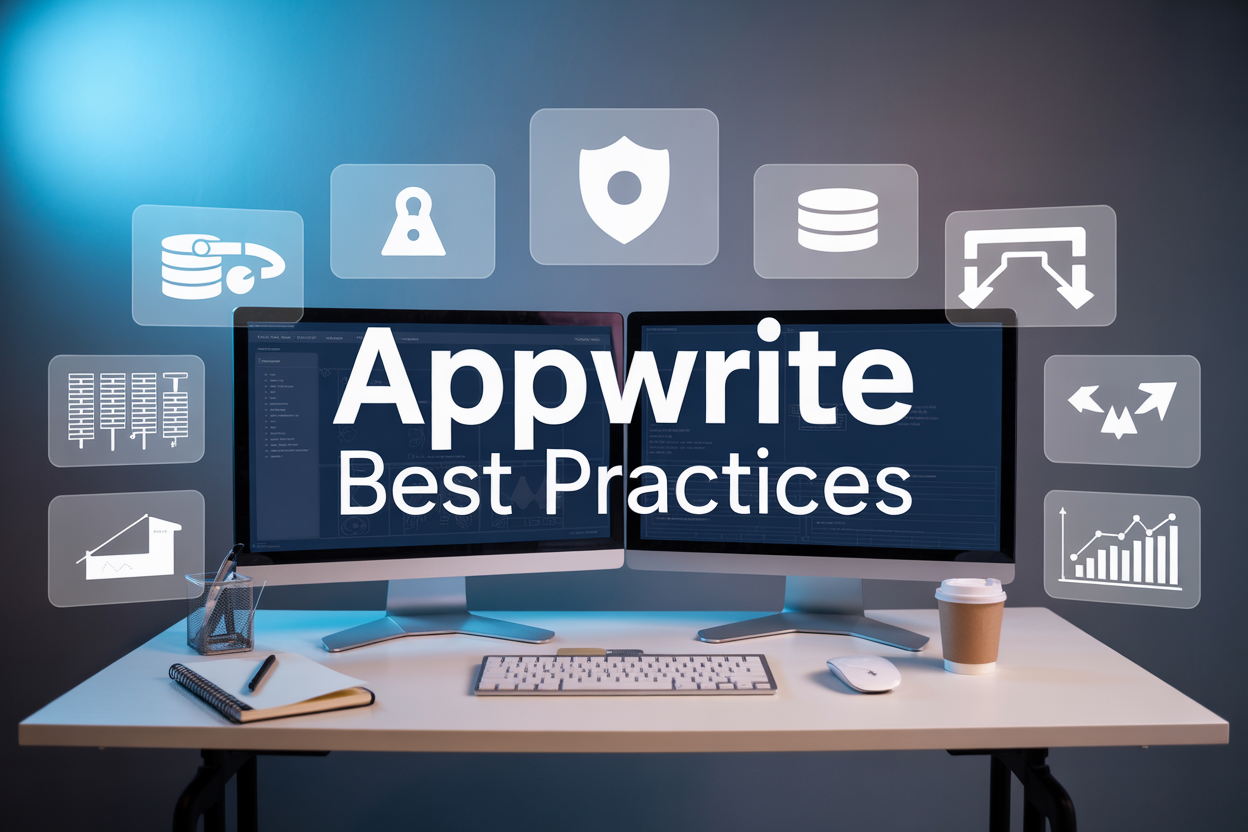Building robust applications with Appwrite requires more than just getting your code to work—it demands strategic planning around security, performance, and scalability. This comprehensive guide covers Appwrite best practices to help you build secure Appwrite apps that perform well under real-world conditions.
This guide is designed for developers, DevOps engineers, and technical leads who want to move beyond basic Appwrite implementations and create production-ready systems. You’ll learn proven strategies for building backends that can handle growth while maintaining security and reliability.
We’ll walk through essential security configuration and authentication techniques to protect your users and data from common vulnerabilities. You’ll discover Appwrite database optimization strategies that keep your queries fast as your user base grows. Finally, we’ll cover scalable architecture design patterns that allow your applications to handle increased traffic without breaking down, plus practical advice for setting up robust production environments with proper monitoring.
Essential Security Configuration and Authentication

Implement Multi-Factor Authentication for Enhanced User Protection
Multi-factor authentication (MFA) stands as your first line of defense when building secure Appwrite apps. Setting up MFA through Appwrite’s authentication service creates multiple verification layers that dramatically reduce unauthorized access risks.
Start by enabling MFA in your Appwrite console under Authentication settings. Configure time-based one-time passwords (TOTP) using authenticator apps like Google Authenticator or Authy. Here’s how to implement MFA in your client application:
// Enable MFA for a user
await account.createMfaAuthenticator('totp');
// Verify MFA challenge
await account.updateMfaAuthenticator('totp', otp);
Consider implementing backup recovery codes for users who lose access to their authenticator devices. Store these codes securely using Appwrite’s encrypted storage capabilities. Phone-based SMS authentication provides an alternative MFA method, though TOTP remains more secure against SIM-swapping attacks.
Test your MFA implementation thoroughly across different devices and browsers. Create fallback mechanisms for users experiencing authentication issues, but ensure these backup methods maintain security standards. Document the MFA setup process clearly for your users to reduce support requests and improve adoption rates.
Configure Proper API Key Management and Access Controls
Effective API key management forms the backbone of secure Appwrite authentication practices. Never expose your API keys in client-side code or commit them to version control systems. Use environment variables and secure configuration management tools to handle sensitive credentials.
Create separate API keys for different environments – development, staging, and production. This separation prevents accidental cross-environment data access and simplifies key rotation procedures. Configure appropriate scopes for each API key, granting only the minimum permissions required for specific functions.
| Environment | Key Scope | Permissions |
|---|---|---|
| Development | Limited | Read/Write test data |
| Staging | Restricted | Production-like access |
| Production | Minimal | Essential operations only |
Implement key rotation schedules, changing API keys every 90 days or immediately after team member departures. Use Appwrite’s team management features to control individual access levels. Set up monitoring alerts for unusual API key usage patterns or failed authentication attempts.
Store API keys using dedicated secret management services like HashiCorp Vault, AWS Secrets Manager, or Azure Key Vault for production deployments. These services provide encryption, access logging, and automated rotation capabilities that enhance your Appwrite security posture.
Set Up SSL/TLS Certificates for Encrypted Data Transmission
SSL/TLS certificates encrypt all data flowing between your applications and Appwrite servers, preventing eavesdropping and man-in-the-middle attacks. Configure HTTPS for all Appwrite endpoints, including custom domains and API calls.
Obtain certificates from trusted certificate authorities (CAs) like Let’s Encrypt, which provides free SSL certificates with automated renewal. For production Appwrite deployments, implement certificate pinning in your mobile applications to prevent certificate substitution attacks:
// Certificate pinning configuration
const client = new Client()
.setEndpoint('https://your-appwrite-server.com/v1')
.setProject('your-project-id')
.setSelfSigned(false); // Ensure SSL verification
Configure HTTP Strict Transport Security (HSTS) headers to force HTTPS connections and prevent protocol downgrade attacks. Set appropriate certificate validity periods – typically 90 days for automated renewals or one year for manually managed certificates.
Monitor certificate expiration dates and set up automated alerts at least 30 days before expiry. Implement certificate transparency monitoring to detect unauthorized certificates issued for your domains. Test SSL configurations using tools like SSL Labs’ SSL Test to identify vulnerabilities or misconfigurations.
Enable Rate Limiting to Prevent Abuse and DDoS Attacks
Rate limiting protects your Appwrite applications from abuse, brute force attacks, and distributed denial-of-service (DDoS) attempts. Configure rate limits at multiple levels – per IP address, per user account, and per API endpoint.
Implement progressive rate limiting strategies that gradually increase restrictions for suspicious behavior. Start with generous limits for legitimate users, then apply stricter controls as request patterns become abnormal:
// Configure rate limiting in Appwrite
const rateLimit = {
requests: 100, // Max requests
duration: 3600, // Per hour
method: 'ip-address' // Limit by IP
};
Set different rate limits for various endpoints based on their computational cost and security sensitivity. Authentication endpoints typically require stricter limits than read-only data queries. Consider implementing sliding window rate limiting for more precise control over request distribution.
Use Appwrite’s built-in rate limiting features combined with external solutions like Cloudflare or AWS WAF for comprehensive protection. Monitor rate limit violations and adjust thresholds based on legitimate traffic patterns. Create whitelists for trusted IP ranges, such as your office networks or partner integrations.
Implement user-friendly error messages for rate-limited requests, providing clear information about when users can retry. Log rate limit violations for security analysis and consider implementing CAPTCHA challenges for borderline cases instead of hard blocks.
Database Optimization and Performance Tuning

Design Efficient Database Schema with Proper Indexing
Creating a well-structured database schema forms the backbone of Appwrite performance optimization. Start by normalizing your data to reduce redundancy while keeping related information accessible. Design collections with clear relationships and avoid deeply nested documents that can slow down queries.
Indexing strategy makes or breaks your database performance. Create indexes on fields you frequently query, sort, or filter by. Compound indexes work best when you search on multiple fields simultaneously. For example, if you regularly query users by both status and created_at, create a compound index on these fields rather than separate ones.
Key indexing practices:
- Index foreign keys and relationship fields
- Create text indexes for search functionality
- Monitor index usage and remove unused indexes
- Consider partial indexes for conditional queries
Avoid over-indexing, as each index consumes storage and slows down write operations. Review your query patterns regularly and adjust indexes accordingly. Appwrite’s built-in analytics help identify which queries take longest and need optimization.
Implement Query Optimization Techniques for Faster Response Times
Query optimization directly impacts your app’s responsiveness and user experience. Write specific queries that fetch only necessary data instead of retrieving entire documents. Use projection to select specific attributes, reducing network overhead and memory usage.
Pagination becomes critical as your dataset grows. Implement cursor-based pagination for better performance compared to offset-based approaches. Appwrite’s query builder supports limit and offset parameters, but cursor pagination scales better with large datasets.
Optimization strategies:
- Use appropriate query operators (
equal,greater,less) instead of complex filters - Batch operations when possible to reduce round trips
- Cache frequently accessed data using Appwrite’s built-in caching
- Implement lazy loading for non-critical data
Monitor query execution times through Appwrite’s console. Slow queries often indicate missing indexes or inefficient query patterns. Set up alerts for queries exceeding acceptable response times, typically above 100ms for simple operations.
Configure Database Connection Pooling for Better Resource Management
Connection pooling prevents database bottlenecks by reusing existing connections instead of creating new ones for each request. Appwrite handles connection pooling automatically, but understanding the configuration helps optimize resource allocation.
Configure pool size based on your expected concurrent users and server capacity. Too few connections create queuing delays, while too many exhaust server resources. Start with 10-20 connections per CPU core and adjust based on monitoring data.
Connection pool configuration considerations:
- Set appropriate timeout values for idle connections
- Monitor connection utilization patterns
- Scale connection pools horizontally across multiple instances
- Implement circuit breakers for database failures
Connection lifecycle management ensures optimal resource usage. Set reasonable timeouts for idle connections to free up resources, but avoid overly aggressive cleanup that forces frequent reconnections. Appwrite’s default settings work well for most applications, but high-traffic apps benefit from custom tuning.
Monitor connection pool metrics including active connections, wait times, and timeout errors. These indicators reveal when you need to adjust pool sizes or investigate underlying performance issues. Proper connection pooling supports your Appwrite scalability goals while maintaining consistent response times under varying loads.
Scalable Architecture Design Patterns

Implement Horizontal Scaling with Load Balancing
Building scalable backend architecture with Appwrite requires distributing your application across multiple server instances. Instead of upgrading to more powerful hardware when traffic increases, horizontal scaling adds more servers to handle the load. This Appwrite scalability approach proves more cost-effective and resilient than vertical scaling.
Set up multiple Appwrite instances behind a load balancer like Nginx, HAProxy, or cloud-native solutions. Configure session affinity carefully since Appwrite maintains stateful connections for real-time features. Use sticky sessions or implement proper session sharing across instances.
Monitor CPU usage, memory consumption, and response times across all instances. When average CPU usage exceeds 70% across your server pool, spin up additional Appwrite containers. Configure health checks that ping /health endpoints to automatically remove failing instances from the load balancer rotation.
Database connections become critical bottlenecks during horizontal scaling. Implement connection pooling and consider read replicas for database-heavy applications. Cache frequently accessed data using Redis or similar solutions to reduce database load across all instances.
Design Microservices Architecture for Better Modularity
Breaking down monolithic applications into microservices improves maintainability and allows independent scaling of different features. With Appwrite, structure your services around business domains rather than technical layers.
Create separate Appwrite projects for distinct service boundaries:
| Service Type | Appwrite Project | Responsibilities |
|---|---|---|
| User Management | auth-service | Authentication, profiles, permissions |
| Content Management | content-service | Posts, media, comments |
| Notification System | notification-service | Email, push, SMS notifications |
| Analytics | analytics-service | User behavior, metrics |
Each microservice maintains its own database and API endpoints. Use Appwrite’s webhook functionality to enable inter-service communication. When users create posts in the content service, trigger webhooks that notify the analytics service to update metrics.
Implement API gateways to route requests to appropriate services and handle cross-cutting concerns like rate limiting and logging. This Appwrite best practices approach prevents service coupling while maintaining clean interfaces between components.
Set Up Auto-scaling Based on Traffic Patterns
Manual scaling reactions often come too late during traffic spikes. Auto-scaling policies monitor key metrics and adjust server capacity proactively. Configure scaling rules based on multiple indicators rather than single metrics.
Define scaling triggers using these metrics:
- CPU utilization: Scale up when average CPU exceeds 75% for 5 minutes
- Memory usage: Add instances when memory consumption hits 80%
- Request queue length: Scale when pending requests exceed 100
- Response time: Trigger scaling when average response time exceeds 2 seconds
Set minimum and maximum instance counts to prevent over-scaling costs and ensure availability. During predictable traffic patterns like daily peaks or seasonal events, implement scheduled scaling that adds capacity before demand increases.
Use cloud provider auto-scaling groups with Appwrite Docker containers. Configure custom AMIs or container images with your Appwrite configuration pre-installed for faster instance launch times.
Monitor scaling events and fine-tune thresholds based on actual traffic patterns. Applications with steady background tasks might need different scaling triggers than user-facing applications with sudden traffic bursts.
Configure CDN Integration for Global Content Delivery
Content Delivery Networks dramatically improve Appwrite performance tuning by serving static assets from edge locations closest to users. Integrate CDNs with Appwrite’s storage buckets to deliver images, videos, and documents with minimal latency worldwide.
Configure your CDN to cache Appwrite storage bucket contents:
// Configure CDN headers for Appwrite storage
const storage = new Storage(client);
// Set cache headers for long-term assets
await storage.createFile(
'bucket-id',
'file-id',
file,
['role:all'],
{
'Cache-Control': 'public, max-age=31536000'
}
);
Set appropriate cache expiration policies based on content types. Static assets like logos and CSS files can have long expiration times (1 year), while user-generated content might cache for shorter periods (24 hours).
Implement cache invalidation strategies for content updates. When users upload new profile pictures, ensure CDN caches refresh across all edge locations. Use CDN APIs to purge specific files or implement versioned URLs that automatically bypass stale cache entries.
Configure geographic distribution rules to comply with data residency requirements. Some regions might require serving content from specific geographic areas due to privacy regulations or performance requirements.
Production Environment Setup and Monitoring

Establish Comprehensive Logging and Error Tracking Systems
Setting up proper logging is your first line of defense when things go wrong in production. Appwrite provides built-in logging capabilities, but you’ll want to configure them thoughtfully to capture the right information without overwhelming your storage or degrading performance.
Start by configuring Appwrite’s log levels appropriately. In development, you might want verbose logging, but production environments should focus on warnings, errors, and critical events. Set your _APP_LOG_LEVEL environment variable to warn or error to reduce noise while capturing important issues.
For comprehensive error tracking, integrate external services like Sentry, Rollbar, or Bugsnag. These platforms offer advanced features like error grouping, release tracking, and performance monitoring that go beyond basic logging. Configure your Appwrite functions to automatically report errors to these services:
// Example error tracking in Appwrite functions
try {
// Your function logic
} catch (error) {
Sentry.captureException(error);
throw error;
}
Structure your logs with consistent formatting and include essential context like user IDs, request IDs, and timestamps. This makes debugging much easier when you’re troubleshooting issues across distributed systems.
Consider implementing centralized log aggregation using tools like ELK Stack (Elasticsearch, Logstash, Kibana) or cloud solutions like AWS CloudWatch or Google Cloud Logging. This allows you to search, filter, and analyze logs from multiple Appwrite instances in one place.
Configure Health Checks and Performance Monitoring
Health checks are essential for maintaining reliable Appwrite production setup. Configure multiple types of health checks to monitor different aspects of your system:
Basic Health Endpoints
Set up endpoints that verify your Appwrite instance is responding correctly. These should check database connectivity, storage availability, and core services:
| Check Type | Endpoint | Purpose |
|---|---|---|
| Basic Health | /health |
Service availability |
| Database | /health/db |
Database connectivity |
| Storage | /health/storage |
File storage access |
| Functions | /health/functions |
Serverless execution |
Performance Metrics
Monitor key performance indicators that directly impact user experience:
- Response times for API calls
- Database query execution times
- Function cold start durations
- Storage upload/download speeds
- Concurrent user sessions
Tools like Grafana combined with Prometheus provide excellent dashboards for visualizing these metrics. Set up alerts when metrics exceed acceptable thresholds – response times over 2 seconds, error rates above 1%, or memory usage exceeding 80%.
Real User Monitoring (RUM)
Implement client-side monitoring to understand actual user experience. Services like New Relic, DataDog, or Google Analytics provide insights into how your app performs in real-world conditions across different devices and networks.
Implement Automated Backup and Disaster Recovery Plans
Data protection should never be an afterthought. Create automated backup strategies that protect both your database and file storage without manual intervention.
Database Backups
Configure regular database backups using your database provider’s native tools. For MySQL or PostgreSQL, set up automated daily backups with point-in-time recovery capabilities:
# Example automated backup script
#!/bin/bash
DB_NAME="appwrite"
BACKUP_DIR="/backups"
DATE=$(date +%Y%m%d_%H%M%S)
mysqldump -u $DB_USER -p$DB_PASSWORD $DB_NAME > $BACKUP_DIR/backup_$DATE.sql
# Upload to cloud storage
aws s3 cp $BACKUP_DIR/backup_$DATE.sql s3://your-backup-bucket/
Storage Backups
Your file storage needs protection too. If using cloud storage providers, enable versioning and cross-region replication. For self-hosted storage, implement regular synchronization to backup locations.
Disaster Recovery Testing
Having backups means nothing if you can’t restore from them quickly. Create documented procedures for different disaster scenarios:
- Database corruption recovery
- Complete server failure restoration
- Partial data loss recovery
- Geographic disaster planning
Test these procedures quarterly using non-production environments. Time each recovery process and document any issues or improvements needed.
Infrastructure as Code
Use tools like Docker Compose, Kubernetes manifests, or Terraform to define your entire Appwrite infrastructure as code. This ensures you can recreate your production environment quickly and consistently if disaster strikes. Store these configurations in version control and maintain them alongside your application code.
Code Quality and Development Workflow

Establish Coding Standards and Best Practices
Building maintainable Appwrite applications starts with consistent coding standards. Create a comprehensive style guide that covers naming conventions for collections, attributes, and functions. Use descriptive names that clearly indicate purpose – instead of generic terms like “data” or “info,” choose specific names like “userProfile” or “orderHistory.”
Implement linting tools like ESLint or Prettier to automatically enforce code formatting. Configure these tools to catch common Appwrite-specific issues, such as improper SDK usage or security vulnerabilities. Document your team’s preferred patterns for handling Appwrite promises, error handling, and data validation.
Establish clear file organization structures. Group related Appwrite services together, separate client-side and server-side code, and maintain consistent folder hierarchies across projects. This organization becomes crucial as your application scales and new team members join.
Create reusable utility functions for common Appwrite operations. Instead of repeating authentication checks or database queries throughout your codebase, build a centralized library of helper functions. This approach reduces bugs and makes updates easier when Appwrite releases new features or deprecates existing ones.
Implement Automated Testing and CI/CD Pipelines
Automated testing forms the backbone of reliable Appwrite applications. Start with unit tests that cover your core business logic, including data validation functions and custom Appwrite function handlers. Mock Appwrite SDK calls during testing to avoid dependencies on external services and ensure tests run quickly.
Integration tests should verify your Appwrite configuration works correctly. Test authentication flows, database permissions, and function executions against a dedicated testing instance. Use tools like Jest or Mocha to create comprehensive test suites that run automatically on code changes.
Set up continuous integration pipelines using GitHub Actions, GitLab CI, or similar platforms. Configure these pipelines to run tests, check code quality, and deploy to staging environments automatically. Include Appwrite-specific checks like validating function code before deployment and ensuring database migrations run successfully.
Implement deployment automation that handles Appwrite configuration updates safely. Use the Appwrite CLI within your CI/CD pipeline to sync collections, attributes, and functions between environments. This automation prevents manual configuration errors that could break production applications.
Set Up Code Review Processes for Quality Assurance
Code reviews catch issues that automated tools miss, especially security concerns and architectural decisions. Establish review checklists that include Appwrite-specific items like permission validation, proper SDK usage, and function error handling.
Train team members to identify common Appwrite pitfalls during reviews. Look for hardcoded credentials, overly permissive database rules, and inefficient query patterns. Pay special attention to authentication logic and data validation, as these areas directly impact application security.
Use pull request templates that prompt developers to explain Appwrite-related changes. Include sections for database schema updates, function modifications, and security considerations. This documentation helps reviewers understand the context and potential impact of changes.
Rotate review responsibilities to spread knowledge across your team. Senior developers should mentor junior team members on Appwrite best practices during the review process. This knowledge sharing prevents single points of failure and improves overall team expertise.
Configure Environment Separation for Development, Staging, and Production
Proper environment separation prevents development mistakes from affecting live users. Create separate Appwrite projects for development, staging, and production environments. Each project should have its own database, authentication settings, and function deployments.
Configure different API keys and endpoints for each environment. Store these credentials securely using environment variables or secret management systems. Never hardcode production credentials in your source code or share them through unsecured channels.
Implement database seeding strategies for development and staging environments. Create scripts that populate test data automatically, allowing developers to work with realistic datasets without compromising production information. Use anonymized or synthetic data that mimics production patterns without exposing sensitive information.
Set up monitoring and alerting that’s appropriate for each environment. Development environments might only need basic logging, while production requires comprehensive monitoring of performance, errors, and security events. Configure staging environments to mirror production monitoring as closely as possible to catch issues before they reach users.
Establish clear promotion processes between environments. Changes should flow from development to staging to production in a controlled manner. Use feature flags to gradually roll out new functionality and maintain the ability to quickly rollback problematic changes without affecting the entire application.

Security should always be your top priority when building with Appwrite. Set up proper authentication flows, configure database permissions carefully, and never skip security reviews before going live. Your users trust you with their data, and getting these fundamentals right from the start saves you countless headaches down the road.
Building production-ready apps means thinking beyond just making things work. Design your architecture to handle growth, optimize your database queries early, and establish solid monitoring practices. The time you spend setting up proper development workflows and code quality checks pays off when your app scales and your team grows. Start with these best practices now, and you’ll thank yourself when your app is serving thousands of users without breaking a sweat.




















